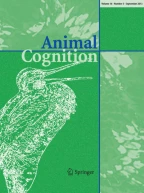Abstract
We used a modified version of the Do as I Do paradigm to investigate dogs’ preference and flexibility in the acquisition of different types of spatial information in social learning situations. When required to match the location of the demonstration, dogs (N = 16) preferentially relied on allocentric information, i.e., the relationship between the location of the demonstration and the various objects surrounding it. However, when allocentric cues were inadequate to solve the task, dogs learned to rely on egocentric information, i.e., the direction—left/right—taken by the human demonstrator. The ease of resorting to the non-preferred egocentric strategy was sex-dependent with males acquiring the egocentric strategy in fewer trials than females. This study shows that dogs rely preferentially on allocentric cues when recalling socially acquired spatial information. However, they are impressively flexible in switching to egocentric strategies according to the task requirements. Whether preference for the allocentric strategy in processing spatial information is embedded in the nature of social learning or restricted to our paradigm is an open question. This study also supports the idea that sex differences in cognitive domains are widespread among mammals and calls for further investigations aimed at shedding light on the evolution, function and mechanisms of such differences.
Similar content being viewed by others
References
Astur RS, Tropp J, Sava S, Constable RT, Markus EJ (2004) Sex differences and correlations in a virtual Morris water task, a virtual radial arm maze, and mental rotation. Behav Brain Res 151:103–115. doi:10.1016/j.bbr.2003.08.024
Ecuyer-Dab I, Robert M (2004) Have sex differences in spatial ability evolved from male competition for mating and female concern for survival? Cognition 91:221–257. doi:10.1016/j.cognition.2003.09.007
Fiset S, Gagnon S, Beaulieu C (2000) Spatial encoding of hidden objects in dogs (Canis familiaris). J Comp Psychol 114:315–324
Fiset S, Beaulieu C, LeBlanc V, Dubé L (2007) Spatial memory of domestic dogs (Canis familiaris) for hidden objects in a detour task. J Exp Psychol 33:497–508. doi:10.1037/0097-7403.33.4.497
Fugazza C, Miklósi Á (2014) Deferred imitation and declarative memory in dogs. Anim Cogn 17:237–247. doi:10.1007/s10071-013-0656-5
Fugazza C, Miklósi A (2015) Social learning in dog training: the effectiveness of the Do as I Do method compared to shaping/clicker training. Appl Anim Behav Sci 171:146–151. doi:10.1016/j.applanim.2015.08.033
Fugazza C, Pogány Á, Miklósi Á (2015) Do as I … Did! Long-term memory of imitative actions in dogs (Canis familiaris). Anim Cogn 19:263–269. doi:10.1007/s10071-015-0931-8
Fugazza C, Pogány Á, Miklósi Á (2016) Spatial generalization of imitation in dogs. J Comp Psychol 130:249–258. doi:10.1037/com0000033
Healy SD, Bacon IE, Haggis O, Harris AP, Kelley LA (2009) Explanations for variation in cognitive ability: behavioural ecology meets comparative cognition. Behav Process 80:288–294. doi:10.1016/j.beproc.2008.10.002
Herman RA, Wallen K (2007) Cognitive performance in rhesus monkeys varies by sex and prenatal androgen exposure. Horm Behav 51:496–507. doi:10.1016/j.yhbeh.2007.01.005
Huber L, Range F, Voelkl B, Szucsich A, Virányi Z, Miklósi Á (2009) The evolution of imitation: what do the capacities of non-human animals tell us about the mechanisms of imitation? Phil Trans R Soc B 364:2299–2309. doi:10.1098/rstb.2009.0060
Jones CM, Healy SD (2006) Differences in cue use and spatial memory in men and women. Proc R Soc B 273:2241–2247. doi:10.1098/rspb.2006.3572
Kubinyi E, Pongrácz P, Miklósi Á (2009) Dog as a model for studying conspecific and heterospecific social learning. J Vet Behav Clin Appl Res 4:31–41. doi:10.1016/j.jveb.2008.08.009
Mongillo P, Araujo J, Pitteri E, Carnier P, Adamelli S, Regolin L, Marinelli L (2013) Spatial reversal learning is impaired by age in pet dogs. Age 35:2273–2282. doi:10.1007/s11357-013-9524-0
Mongillo P, Pitteri E, Candaten M, Marinelli L (2016) Can attention be taught? Interspecific attention in dogs (Canis familiaris) performing obedience tasks. Appl Anim Behav Sci 182:30–37. doi:10.1016/j.applanim.2016.05.018
Müller CA, Mayer C, Dörrenberg S, Huber L, Range F (2011) Female but not male dogs respond to a size constancy violation. Biol Lett 7:689–691. doi:10.1098/rsbl.2011.0287
Range F, Viranyi Z (2013) Social learning from humans or conspecifics: differences and similarities between wolves and dogs. Front Psychol 4:868. doi:10.3389/fpsyg.2013.00868
Ray E, Heyes C (2002) Do rats in a two-action test encode movement egocentrically or allocentrically? Anim Cogn 4:245–252. doi:10.1007/s10071-002-0154-7
Topál J, Byrne R, Miklósi Á, Csányi V (2006) Reproducing human actions and action sequences: “Do as I Do!” in a dog. Anim Cogn 9:355–367. doi:10.1007/s10071-006-0051-6
Zentall TR (2006) Imitation: definitions, evidence, and mechanisms. Anim Cogn 9:335–353. doi:10.1007/s1007-006-0039-2
Acknowledgements
This study was funded by the University of Padua (CPDA144871/14). Dr. Claudia Fugazza received a post doc grant (CPDR148844) from the University of Padua. We are very grateful to Pamela Sambugaro for assistance with data collection and all the dogs’ owners volunteering this study.
Author information
Authors and Affiliations
Corresponding author
Ethics declarations
Conflict of interest
The authors declare that they have no conflict of interests.
Ethical standards
All procedures performed in the present study were in accordance with the ethical standards of the University of Padua and Italian law. No specific permission was required, given the nature of the study.
Rights and permissions
About this article
Cite this article
Fugazza, C., Mongillo, P. & Marinelli, L. Sex differences in dogs’ social learning of spatial information. Anim Cogn 20, 789–794 (2017). https://doi.org/10.1007/s10071-017-1099-1
Received:
Revised:
Accepted:
Published:
Issue Date:
DOI: https://doi.org/10.1007/s10071-017-1099-1
